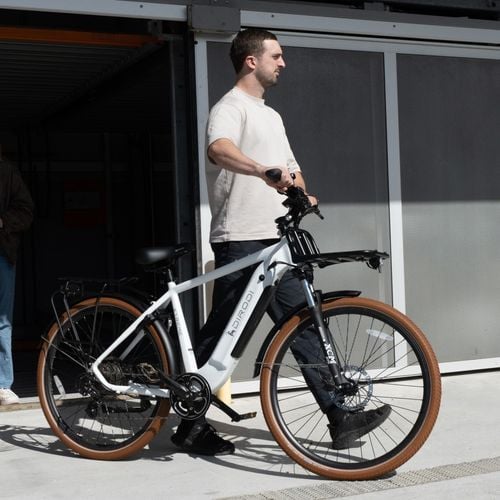Avoid These 7 Mistakes When Buying an Electric Bike!
Are you considering buying an e-bike in Australia? E-bikes offer a fantastic alternative for commuting, road trips, or off-road adventures.
However, before you go out and purchase your first e-bike it is crucial to make an informed decision when purchasing an e-bike to avoid potential pitfalls. To help you, we've compiled a list of mistakes people make when buying an e-bike. Let's dive in!

Mistake #1: Not Considering Your Specific Needs
E-bikes serve specific purposes like commuting, recreational riding, mountain biking, and cargo transport. Each type is tailored with features for optimal performance. Failing to match your needs can result in dissatisfaction and underperformance.
Commuter E-Bikes: Commuter e-bikes are tailored for urban environments, emphasizing smooth and efficient rides on city streets. They often include integrated lights, fenders, and puncture-resistant tyres for added convenience and durability. Some models may feature front suspension to reduce road vibrations. However, their focus on pavement optimization may present challenges when traversing rugged trails or off-road terrain.
Mountain E-Bikes: Mountain e-bikes are designed for challenging terrains, featuring suspension systems and off-road tyres. However, these features can be unnecessary and cumbersome for urban commuting, reducing speed and adding weight. Additionally, the suspension and knobbly tyres can reduce pedaling efficiency and create more rolling resistance on flat, urban roads.

Fat Tyre E-bikes: Fat tyre e-bikes provide stability and exceptional traction on soft or uneven surfaces, making them versatile for on- and off-road riding. Despite misconceptions about wider tyres, the electric motor compensates for any potential slowdown.
Road E-bikes: Road e-bikes are designed for speed and efficiency on paved surfaces, with lightweight frames, narrow tyres, and an aerodynamic riding position. Ideal for long-distance rides on smooth roads, they cater to fitness enthusiasts and competitive riders. However, they are unsuitable for rough terrains or casual riding, as using them off-road can cause discomfort and potential damage.
Cargo E-Bikes: Cargo e-bikes are built to transport heavy loads, suitable for goods, groceries, or children. They boast sturdy frames, strong motors, and long wheelbases for stability. Equipped with cargo racks, baskets, or passenger seats, they excel in heavy-duty tasks. However, their bulkier size and weight can limit agility and storage options. Moreover, carrying heavy loads may accelerate battery depletion.
Overall, the fat tyre e-bike is unmatched in its versatility across terrains. Unlike other e-bikes tailored for specific environments, fat tyre models thrive on urban streets and rugged trails alike.
Mistake #2: Don't Choose Wrong Battery Size
Selecting the right battery size is crucial for maximising your e-bike's performance and ensuring a satisfying riding experience.
- Assess the battery's type and size, determined by voltage and amp power (V & AH).
- Avoid purchasing a small battery, which may lead to range anxiety and charging issues.
- Don't choose the wrong battery: calculate your daily range and add a safety margin of 30% to 50% to determine the right battery size.
- Measure watt/hour calculations for accuracy, aiming for 150-200 watt/hour for a range of about 20 km with middle pedal assist, halved under full throttle.
- Prioritise premium battery cells from reputable brands for a longer lifespan.
- Avoid lower-grade cells with shorter lifespans.

Mistake #3: Check Return Policy
When purchasing an e-bike, it's essential to check the return policy to ensure peace of mind and a smooth buying experience. Here's why:
By reviewing the return policy, you can feel more confident about your purchase, knowing that you have the option to return the e-bike if it doesn't meet your expectations.
Despite thorough research and reviews, it's challenging to gauge how well an e-bike suits your needs until you've ridden it. A return policy allows you to test ride the bike and assess its comfort, performance, and suitability.
A robust return policy often reflects the retailer's confidence in the quality of their products. It signals that they stand behind their e-bikes and are committed to customer satisfaction.
While a return policy may offer the option to return an e-bike if it doesn't meet your expectations, there are often stipulations that need to be considered. For example, some manufacturers may not accept returns for used bikes, or they may require the bike to be in its original packaging with all accessories included. Additionally, certain retailers may impose restocking fees or other charges for returned items.
Mistake #4: Check Accessories that Come With the Bike
It's important to be aware that some manufacturers may not include accessories like baskets or bike stands, even if they are shown in the images online. While these accessories may appear in promotional materials or product images, they may not be included with the purchase of the e-bike itself.
To avoid any misunderstandings, it's advisable to carefully read the product description and specifications provided by the manufacturer or retailer to determine exactly what is included with the e-bike purchase.

Mistake #5: Don't Purchase From Unknown Brands
When considering the purchase of an e-bike, it's essential to avoid buying from unknown or unestablished brands. Here's why:
Quality Concerns: Unknown brands may lack a reputation for producing high-quality e-bikes. Without established credibility, there's a higher risk of purchasing a bike that doesn't meet safety standards or is prone to malfunctions.
Limited Support and Warranty: Established brands typically offer warranties and reliable customer support. However, with unknown brands, you may encounter difficulties in accessing support services or resolving issues with your e-bike.
Lack of Reviews and Feedback: Established brands often have a wealth of reviews and feedback from customers, providing valuable insights into the performance and reliability of their e-bikes. On the other hand, e-bikes from unknown brands may lack sufficient reviews, making it challenging to assess their quality and performance.
Potential Safety Risks: E-bikes involve complex electrical systems and components. Purchasing from unknown brands increases the risk of safety hazards due to poor manufacturing practices or inadequate quality control measures. It's crucial to avoid e-bikes with unbranded or low-quality batteries and chargers. The quality of the battery significantly impacts both the lifespan and safety of the e-bike. While low-quality, unbranded batteries may fail within a year, premium battery cells from reputable manufacturers like Samsung, LG, Panasonic, Lishen, and Eve can last 2-4 years or even longer. The battery is often the most expensive component of the e-bike, and frequent replacements can quickly negate any initial savings from buying a cheaper model. More importantly, premium batteries not only have a longer lifespan but also provide enhanced safety. These batteries use high-quality cells, and when paired with a well-designed battery management system (BMS), they significantly reduce the risk of failures such as short circuits or overcharging. It's also essential to consider the manufacturer of the battery pack, as proper assembly and adherence to safety standards, such as UL certification, ensure a higher level of protection. DiroDi, for instance, has voluntarily started adopting UL certification for its e-bike batteries (starting from the Rover Gen 5 model). UL certification requires the battery to have at least two layers of protection against various types of failures, such as short circuits, overcharging, over-discharging, and thermal issues.
While e-bikes from unknown brands may appear more affordable initially, they often come with hidden risks and potential drawbacks that outweigh any perceived cost savings.
Mistake #6: Check Warranty and Fine Print
It's crucial to carefully review the manufacturer's warranty and its fine print, as the warranty may vary between manufacturers.
The manufacturer's warranty outlines which components of the e-bike are covered and for how long. It typically includes coverage for the frame, motor, battery, and electronic components.
The fine print of the warranty often contains exclusions and limitations that may affect coverage. These could include neglect, misuse, unauthorised modifications, or failure to adhere to maintenance requirements.
It is also important to understand that different components of the e-bike may have varying warranty periods. For example, the frame may have a longer warranty than the components or electronics.
Lastly, some warranties may be transferable, meaning they can be transferred to a new owner if you decide to sell the e-bike. Others are non-transferable and may only apply to the original purchaser.

Mistake #7: After Support and Servicing
E-bikes are intricate machines with electronic components that may require servicing or troubleshooting over time. Therefore, ensuring that the manufacturer or retailer offers reliable technical assistance is essential for addressing any post-purchase issues that may arise. Additionally, some manufacturers have authorised service centres and online technical staff for after-sales support.
Another critical aspect to consider is the availability of spare parts. Timely access to spare parts is vital for carrying out repairs and maintenance efficiently.
Checking for the availability of these resources ensures that you have the necessary information to properly care for your e-bike.